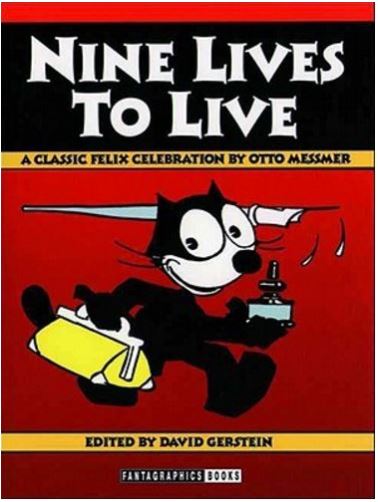
By Otto Messmer, edited by David Gerstein (Fantagraphics Books)
ISBN: 978-1-56097-308-9 (HB)
It might surprise you to know, but funny kitties actually pre-date the internet. They are still big at trick or treat time though…
Unless you’re as old as me, Felix is a hilarious, antic-enjoying talking cat of incredibly ancient vintage. His origins are confused, contentious and still challenged. I’m going with…
Felix was created by Otto Messmer for Australian Pat Sullivan’s animation studio between 1915 and 1917 and was an overnight global hit. Those moving picture cartoons led to a long supplementary career as a newspaper strip, as well as a plethora of merchandisable products in many other media.
Messmer wrote and drew the Sunday newspaper strip – which first premiered in London papers – before the feature finally launched in the USA on August 19th 1923. As Messmer’s employer and boss, Sullivan re-inked those initial strips, signed them, and then took the credit for both strips and even the animated cartoons, which Messmer carried on directing until 1931.
Otto quietly toiled on, producing Sunday pages and daily strips for decades. In 1955, his assistant Joe Oriolo took over the creative duties: simultaneously starting a campaign to return the credit for Felix’s invention and exploits to the “true” originator. It wasn’t until the 1960s that shy, loyal, brilliant Otto Messmer finally admitted what most of the industry had known for years…
As the cat evolved via successive movie shorts – and eventually numerous TV appearances – an additional and ever-expanding paraphernalia of mad professors, clunky robots and the fancy feline’s fantastical Bag of Tricks gradually became icons of Felix’s magical world, but most of that is the stuff of a later time and – hopefully one day – another collected volume.
The early work collected here comes from the halcyon 1920’s and displays a profoundly different kind of whimsy. Fast-paced slapstick, fantastic invention and, yes, a few images and gags that might arch the collective metaphorical eyebrow of our more enlightened times; these are the strips that caught the world’s imagination more than a century ago.
This was a time when even the modern citizens of America and Great Britain were social primitives compared to us – or at least so I’d like to think… until I read a paper or watch the news…
The imagination and wonderment of George Herriman’s Krazy Kat and Cliff Sterrett’s Polly and her Pals – both so similar to Felix in style, tone and execution – got the same responses from their contemporary readership and with the same sole intent: make the reader laugh.
Our modern response of casually and frequently lazily labelling as racist or sexist any such historical incidence in popular art-forms, whilst ignoring the same “sins” in High Art, is the worst kind of aesthetic bigotry, and usually prompted by opportunistic bias or dog-whistle opportunism and it really truly ticks me off.
Why not use those incensed sensibilities to confront the still-present injustices and inequalities so many people are still – and often increasingly – enduring rather than take a cheap shot at the bygone, far-less-enlightened world when most creators had no conception of the potential ramifications of their efforts?
Sorry about that, but the point remains that the history of our artform is always going to be curtailed and covert if we are not allowed the same “conditional discharge” afforded to film, ballet, opera, painting or novels. When was the last time anybody demanded that Oliver Twist was banned or shunned because of its depiction of a Jew? And if you’re going to legislate against Tootsie, Mrs. Doubtfire, Nuns on the Run or Twelfth Night, don’t do it unless you want bigots and cretins to vote for you.
The modern rush to brand or Other any form of existence lived after Oliver Cromwell died actually shuts down debate before anything can be achieved to fix or even address the issue…
And it’s rants like that that really scare people…
None of which alters the fact that Felix the Cat is a brilliant and vitally important comic strip by an unsung genius. The wonderful work collected here – which include hundreds of rowdily phantasmagorical Daily and Sunday strips plus a comprehensive biography, filmography and TV videography section – perfectly encapsulates the wonder, universal charm and rapid-fire, surreal gags that enchanted generations and will still delight and enthral youngsters of all ages.
It’s long past time that this cat came back…
© 1996 O.G. Publishing Corp.
